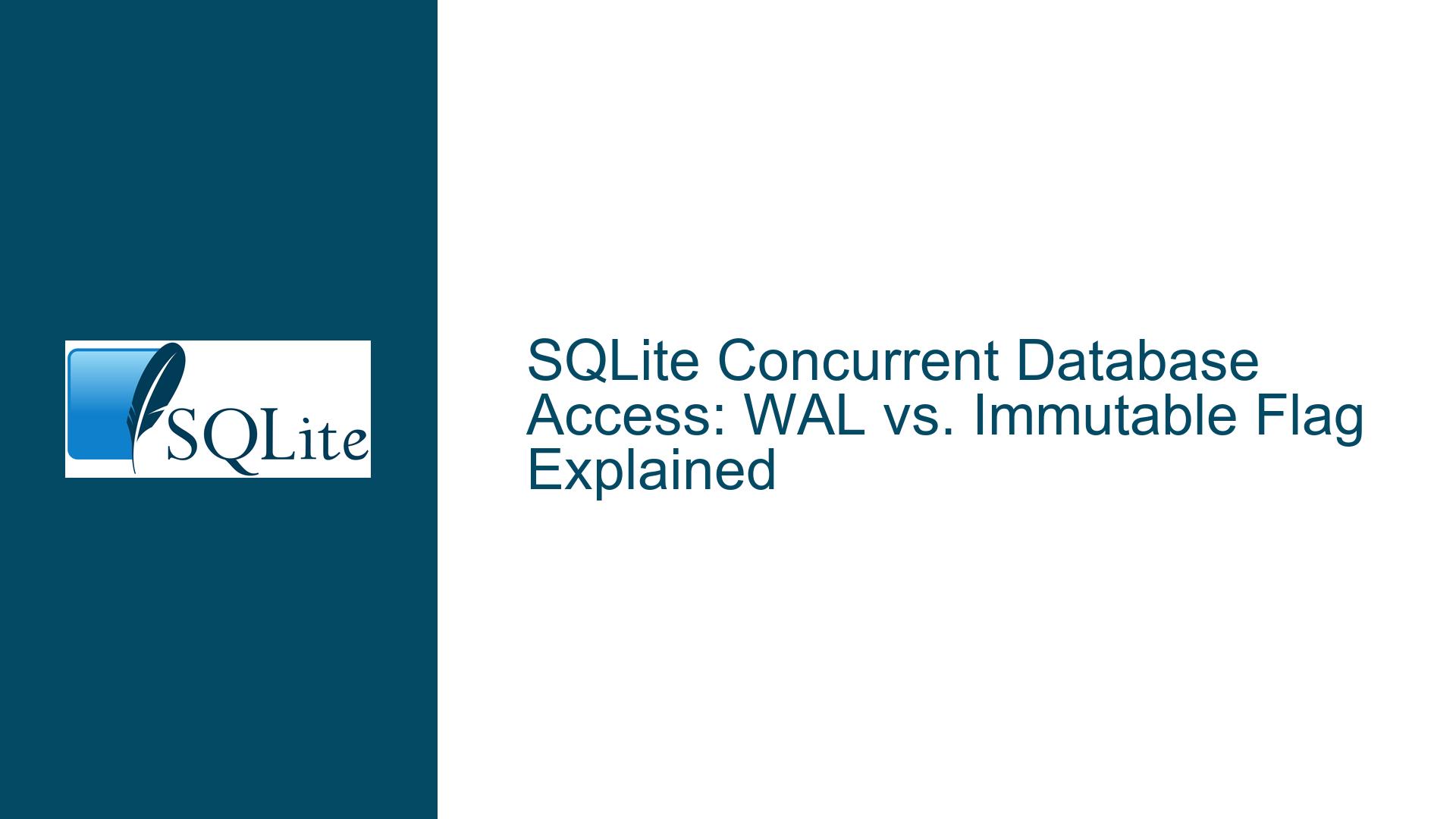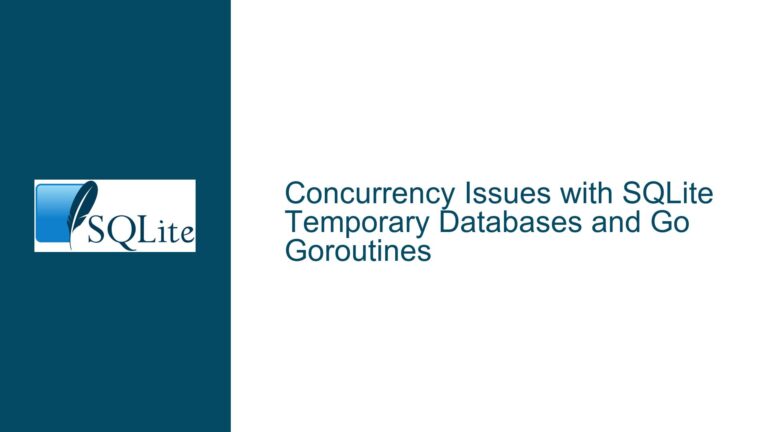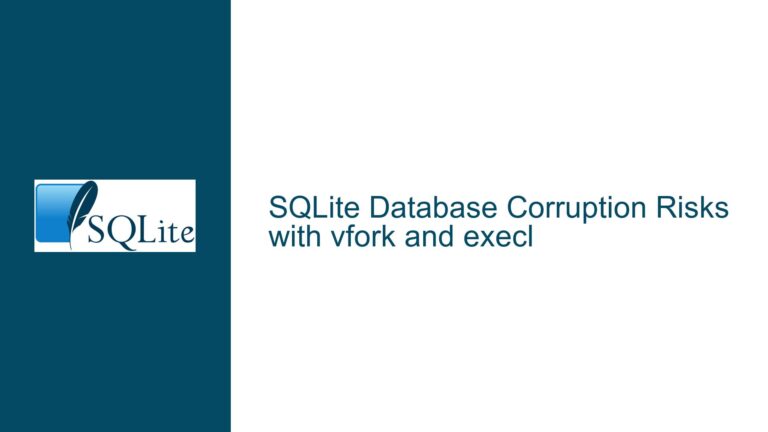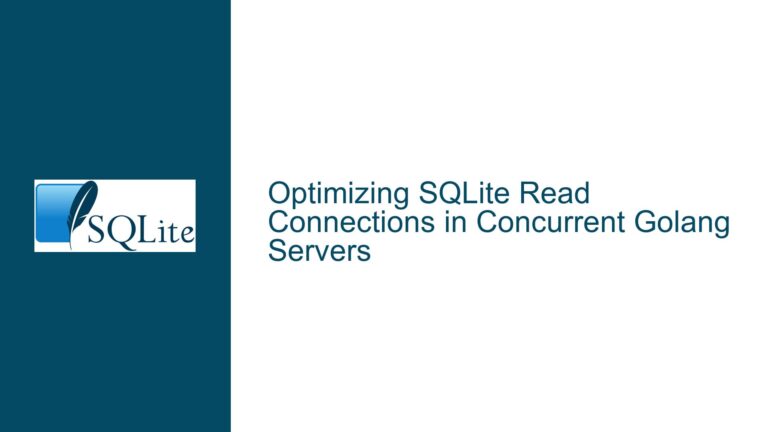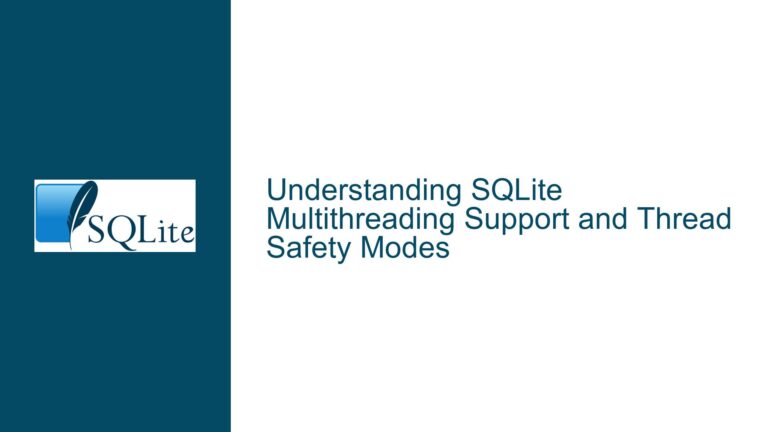SQLite Concurrent Database Access: WAL vs. Immutable Flag Explained
Understanding Concurrent Database Access in SQLite
SQLite is a lightweight, serverless database engine that is widely used in applications ranging from embedded systems to mobile apps. One of the most common questions developers have is whether multiple applications or multiple instances of the same application can access a single SQLite database file simultaneously. The short answer is yes, but the details are nuanced and depend on the configuration and mode of operation. This post will explore the intricacies of concurrent access in SQLite, focusing on two primary mechanisms: Write-Ahead Logging (WAL) and the immutable=1 URI flag. We will also discuss the trade-offs, limitations, and best practices for each approach.
The Role of WAL and Immutable Flag in Concurrent Access
Write-Ahead Logging (WAL) Mode
Write-Ahead Logging (WAL) is a feature in SQLite that allows multiple readers and a single writer to operate on the database concurrently without blocking each other. In WAL mode, changes are written to a separate WAL file instead of directly to the main database file. Readers can continue to access the database without being blocked by writers, and writers can make changes without blocking readers. This is a significant improvement over the default rollback journal mode, where writers exclusively lock the database, preventing other processes from reading or writing.
WAL mode is particularly useful in scenarios where read operations far outnumber write operations. For example, in a web application serving a high volume of read requests, WAL mode ensures that readers are not blocked by occasional write operations. However, WAL mode is not without its drawbacks. One notable limitation is the need for periodic checkpointing, where changes in the WAL file are transferred back to the main database file. During checkpointing, there may be brief periods where readers are blocked, although these are generally short-lived.
Another consideration with WAL mode is that it requires shared memory support, which may not be available on all platforms. Additionally, WAL mode can increase the complexity of backup and recovery processes, as both the main database file and the WAL file need to be considered.
The immutable=1 URI Flag
The immutable=1 URI flag is another mechanism that can be used to enable concurrent access to an SQLite database. When this flag is set, SQLite treats the database file as immutable, meaning it assumes that the file will not be modified by any other process. This allows multiple processes to read from the database simultaneously without any locking or coordination.
The immutable=1 flag is particularly useful in scenarios where the database is read-only or where the database file is stored on a read-only filesystem. For example, if you are distributing a pre-populated SQLite database with your application and do not expect users to modify it, the immutable=1 flag can be a simple and effective way to enable concurrent access.
However, the immutable=1 flag has significant limitations. Most notably, it completely disables write operations. If any process attempts to write to the database while the immutable=1 flag is set, the operation will fail. This makes the flag unsuitable for use cases where the database needs to be updated, even infrequently. Additionally, the immutable=1 flag does not provide any of the benefits of WAL mode, such as improved concurrency for mixed read/write workloads.
Troubleshooting Concurrent Access Issues and Choosing the Right Solution
Diagnosing Concurrent Access Problems
When dealing with concurrent access issues in SQLite, the first step is to identify the symptoms and determine whether they are related to locking, contention, or configuration. Common symptoms include:
- Database Locked Errors: These occur when a process is unable to acquire a lock on the database, typically because another process is holding an exclusive lock. This is more common in rollback journal mode but can also occur in WAL mode during checkpointing.
- Performance Degradation: If your application experiences slow performance under load, it may be due to contention between readers and writers. This is especially likely in rollback journal mode, where writers block readers and vice versa.
- Data Corruption: In rare cases, improper handling of concurrent access can lead to data corruption. This is more likely to occur if multiple processes are writing to the database without proper coordination.
To diagnose these issues, you can use SQLite’s built-in diagnostic tools, such as the sqlite3_trace function, which logs SQL statements and their execution times. You can also enable the SQLITE_DEBUG compile-time option to get more detailed information about locking and contention.
Choosing Between WAL Mode and the Immutable Flag
The choice between WAL mode and the immutable=1 flag depends on your specific use case and requirements. Here are some guidelines to help you decide:
Use WAL Mode If:
- Your application has a mixed read/write workload.
- You need to support concurrent readers and writers.
- You are willing to manage the additional complexity of WAL mode, including checkpointing and backup procedures.
- Your platform supports shared memory, which is required for WAL mode.
Use the
immutable=1Flag If:- Your database is read-only or stored on a read-only filesystem.
- You do not need to support write operations.
- You want a simple solution for enabling concurrent read access without the overhead of WAL mode.
Best Practices for Concurrent Access
Regardless of whether you choose WAL mode or the immutable=1 flag, there are several best practices you should follow to ensure reliable and efficient concurrent access:
- Minimize Write Operations: In WAL mode, frequent write operations can lead to contention and performance degradation. Try to batch write operations or schedule them during periods of low activity.
- Monitor Checkpointing: In WAL mode, checkpointing can cause brief periods of contention. Monitor the checkpointing process and adjust the checkpoint interval if necessary.
- Use Connection Pooling: Connection pooling can help reduce the overhead of establishing and tearing down database connections, which is especially important in high-concurrency scenarios.
- Test Under Load: Always test your application under realistic load conditions to identify and address any concurrency issues before deploying to production.
Advanced Techniques for High-Concurrency Scenarios
For applications with extremely high concurrency requirements, you may need to go beyond WAL mode and the immutable=1 flag. Here are some advanced techniques to consider:
- Sharding: Splitting your database into multiple smaller databases (shards) can help distribute the load and reduce contention. Each shard can be accessed independently, allowing for greater parallelism.
- Replication: Using a replication mechanism to maintain multiple copies of your database can improve read scalability. However, this introduces additional complexity, as you will need to manage synchronization between replicas.
- Application-Level Locking: In some cases, you may need to implement application-level locking to coordinate access to shared resources. This can be done using a distributed lock manager or a custom locking mechanism.
Common Pitfalls and How to Avoid Them
- Overlooking Platform Limitations: Not all platforms support WAL mode or the
immutable=1flag. Always verify that your platform supports the features you plan to use. - Ignoring Checkpointing: In WAL mode, failing to manage checkpointing can lead to performance issues. Make sure to monitor and adjust the checkpointing process as needed.
- Misconfiguring the Immutable Flag: Using the
immutable=1flag in a write-heavy scenario can lead to errors and data loss. Ensure that the flag is only used in read-only scenarios. - Neglecting Backup and Recovery: Both WAL mode and the
immutable=1flag can complicate backup and recovery processes. Make sure to test your backup and recovery procedures thoroughly.
Conclusion
Concurrent access to an SQLite database is a complex topic that requires careful consideration of your application’s requirements and constraints. By understanding the trade-offs between WAL mode and the immutable=1 flag, and by following best practices for concurrent access, you can ensure that your application performs reliably and efficiently under load. Whether you choose WAL mode for its flexibility or the immutable=1 flag for its simplicity, the key is to make an informed decision based on your specific use case.
